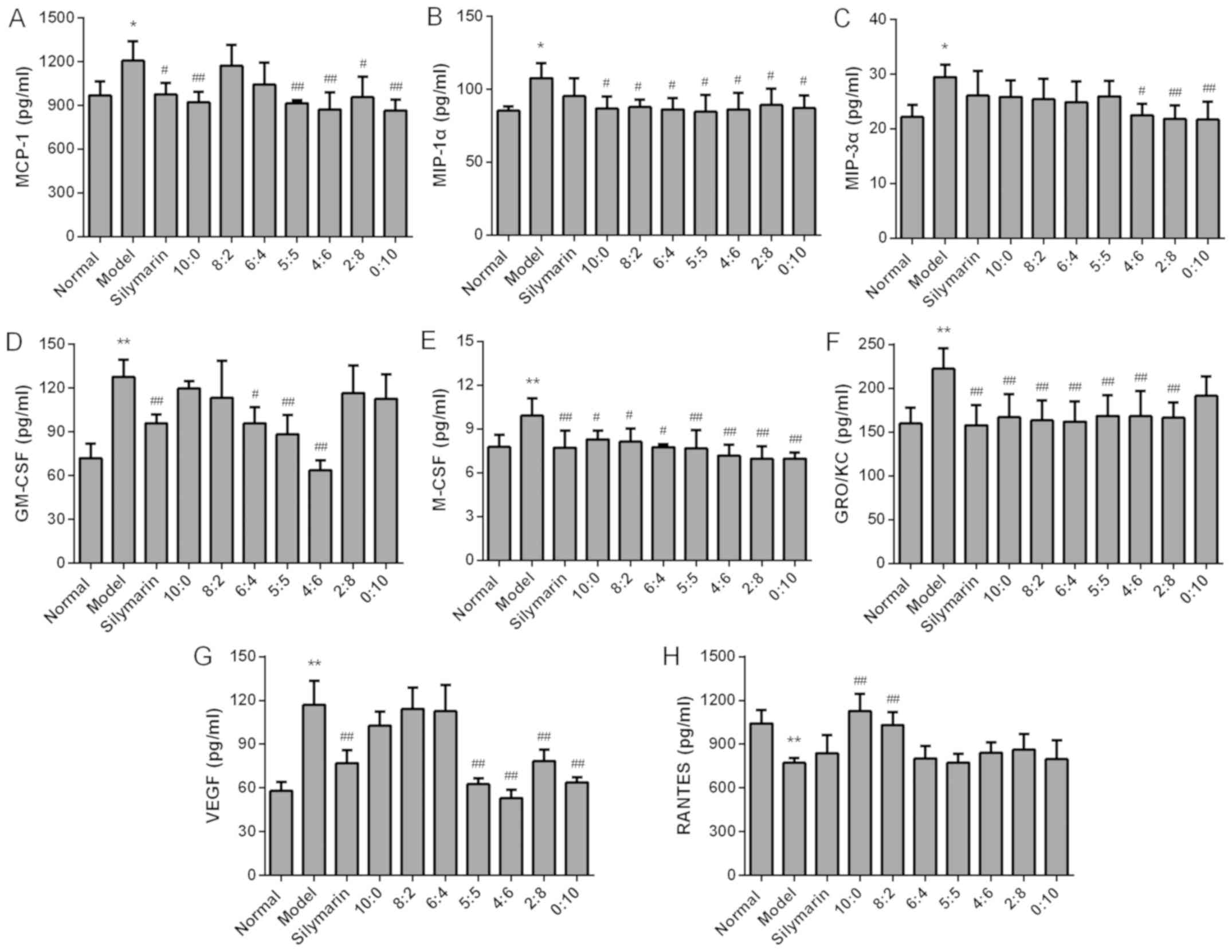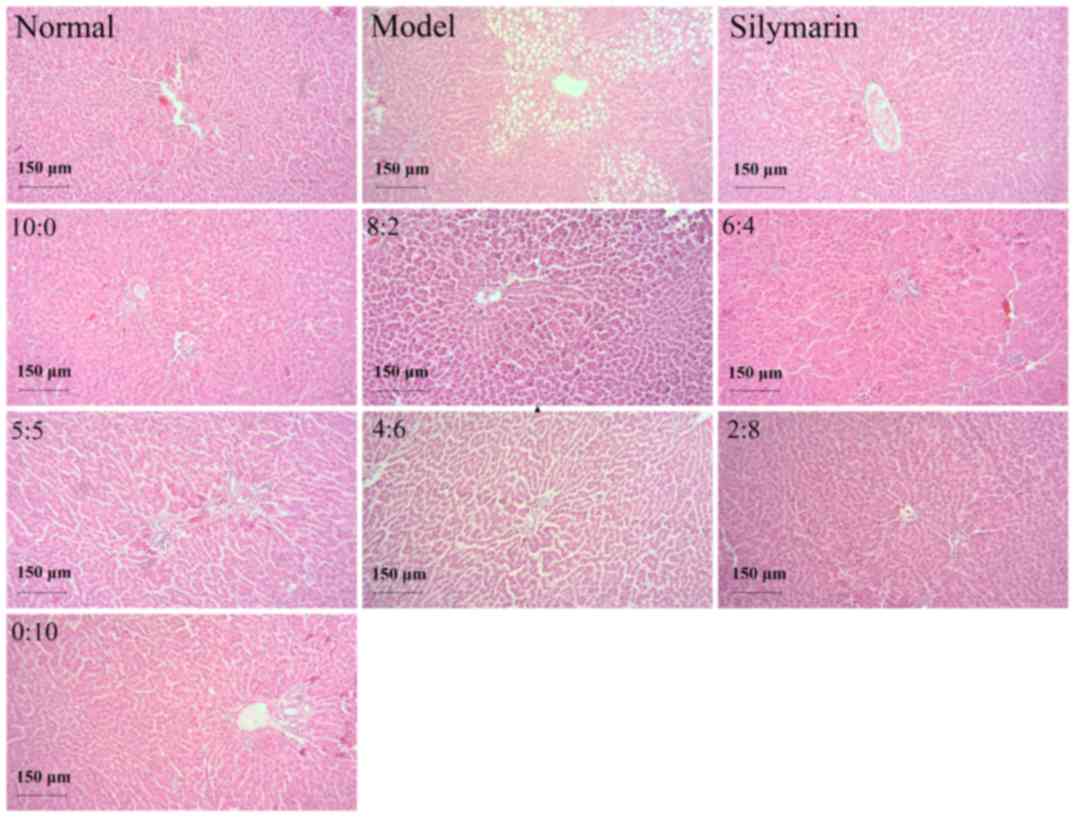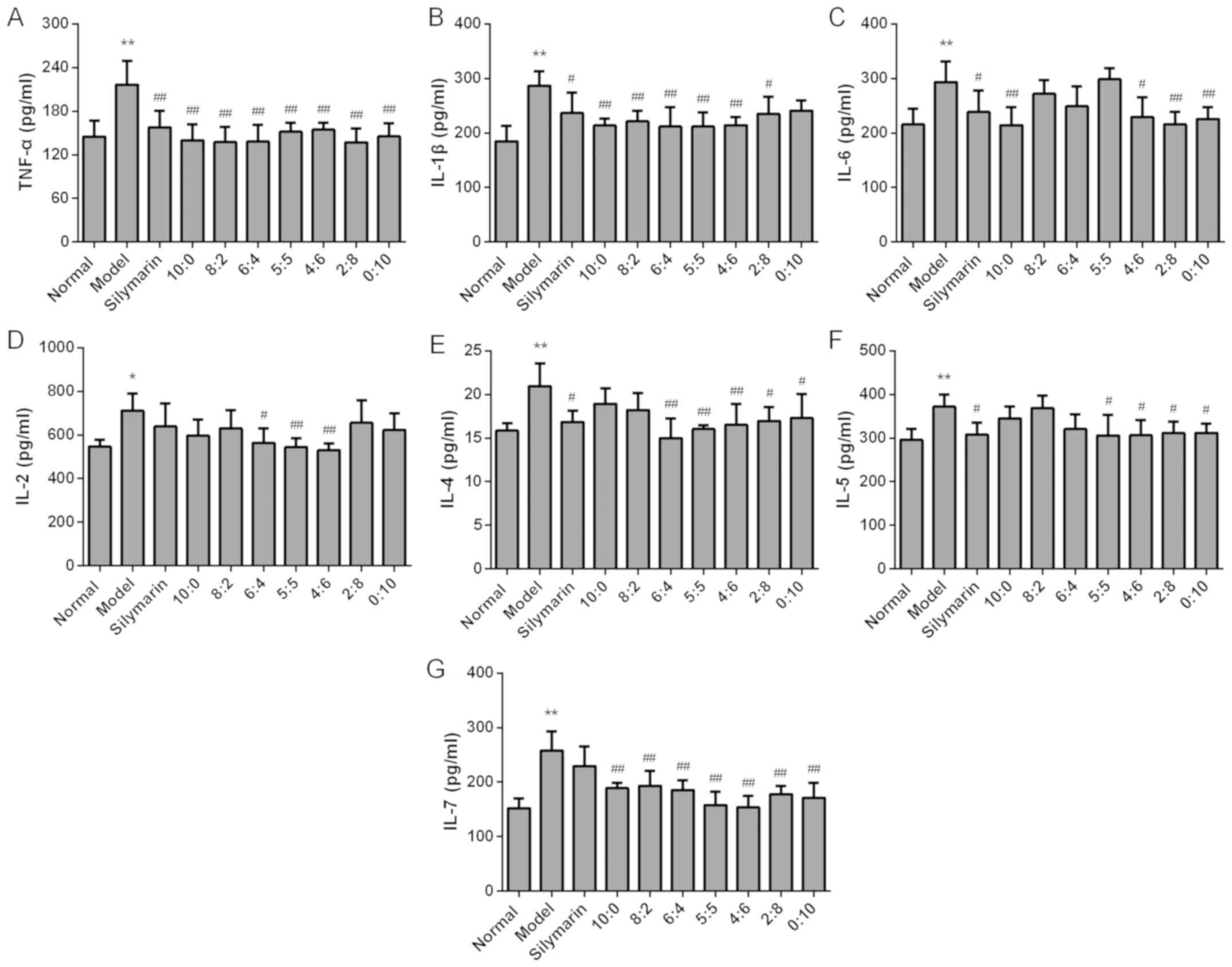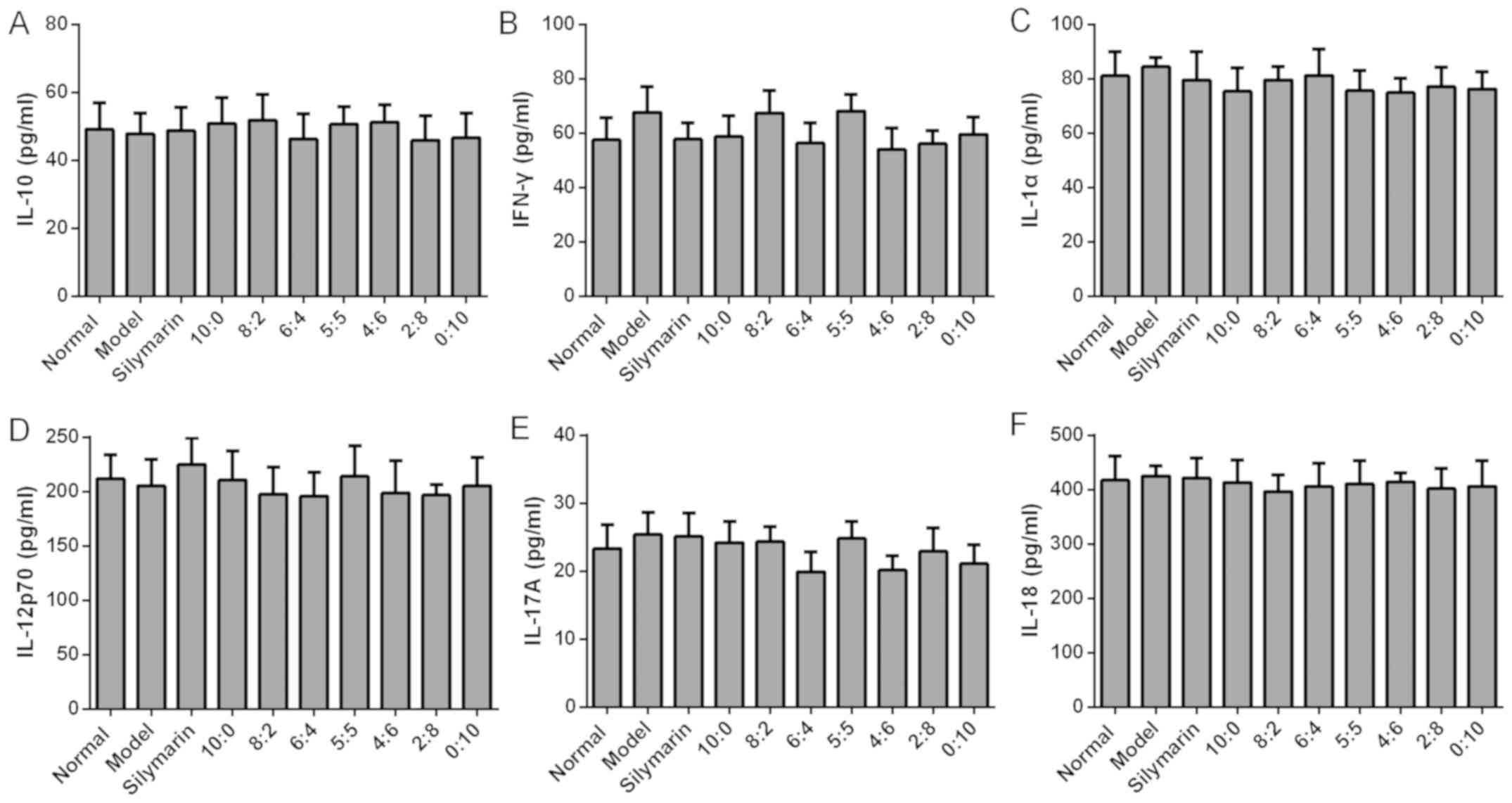Introduction
Alcoholic liver disease (ALD) encompasses a spectrum
of injury, including simple steatosis, alcoholic hepatitis (AH),
fibrosis, cirrhosis and hepatocellular carcinoma. Among these, AH
draws increasing attention due to its high incidence (1,2). The
molecular mechanisms of AH are complex; however, cytokines and
chemokines associated with AH are considered to be essential in the
progression of AH (3–5). AH is typically characterized by
inflammation, which is accompanied by a marked increase of
pro-inflammatory cytokines and chemokines. Alcohol may accelerate
AH by increasing the translocation of gut-derived endotoxins to the
portal circulation, activating the lipopolysaccharide
(LPS)/Toll-like receptor-4 (TLR-4) pathway (6), and promoting hepatocyte or Kupffer
cells to release cytokines and chemokines, including interleukin
(IL)-6, IL-1α, tumor necrosis factor (TNF)-α and monocyte
chemotactic protein 1 (MCP-1) (7–9). Thus,
modulation of cytokines and chemokines associated with AH may help
to protect against AH.
Due to its health benefits and relatively low
toxicity, liquorice, the root and stolon of certain
Glycyrrhiza species, has been used to treat certain diseases
for thousands of years (10). It has
also been widely used in food products as a sweetening and
flavoring component owing to its sweet taste. Glycyrrhizic acid
(GA), with two different epimers, 18α- and 18β-GA, may be isolated
from liquorice (11,12), and is known for its medicinal
properties, including anti-inflammatory and immune regulatory
actions, as well as inhibition of hepatic apoptosis and necrosis
(13,14). GA was reported to attenuate the
TLR-4/myeloid differentiation factor-2 complex, thus suppressing
LPS-induced activation of signal cascades and production of
cytokines and chemokines (15). GA
also exerts anti-inflammatory effects by reducing the production of
pro-inflammatory cytokines. Accumulating evidence indicates that
these two epimers of GA have different pharmacological functions.
18α-GA exhibits anti-inflammatory activity, while, 18β-GA modulates
bile acid metabolism (16,17). Thus, the present study hypothesized
that different ratios of 18α- and 18β-GA may have different effects
against AH. However, to date, the optimal ratio of 18α- and 18β-GA
to synergistically prevent AH and the underlying mechanisms of
these protective effects have remained elusive.
The present study was therefore designed to
investigate the optimal ratio of 18α- and 18β-GA for preventing AH,
and further, to explore the underlying mechanisms by detecting
their effects on cytokines and chemokines associated with AH.
Materials and methods
Materials and reagents
Magnesium isoglycyrrhizinate injection
(18α:18β=500:1) was provided by Chia Tai Tianqing Pharmaceutical
Group Co., Ltd (Lianyungang, China) (18). Compound ammonium glycyrrhetate S for
Injection (18α:18β=1:109) was purchased from Shanxi Powerdone
Pharmaceutics Co., Ltd. (Datong, China) and Silibinin Capsules
(purity, >99%) was supplied by Tianjin Tasly Sants
Pharmaceutical Co., Ltd. (Tianjin, China) (18). Alcohol (>98%) was purchased from
Tianjin Fengchuan Chemical Regent Technologies Co., Ltd. (Tianjin,
China). The Bio-Plex Pro™ Rat Cytokine Group I Panel 23-Plex
kit (cat. no. 12005641) was supplied by Bio-Rad Laboratories, Inc.
(Hercules, CA, USA). All other reagents were of analytical
grade.
Animals and animal treatments
A total of 60 Male Sprague Dawley rats (weight
200±20 g) were purchased from SPF Laboratory Animal Technology Co.,
Ltd. (Beijing, China). All rats were kept in a room with controlled
humidity and temperature under a 12-h light/dark cycle. The animals
were given free access to purified water and a standard diet.
Animal models
The rats were randomly divided into ten groups of
ten rats in each group (n=6): i) normal group (0.9% saline), ii)
model group [alcohol (40%; 10 ml/kg)], iii) silymarin (positive
control) group [alcohol + silymarin (22.75 mg/kg)], iv-x) different
18α- and 18β-GA groups [ratios, 10:0, 8:2, 6:4, 5:5, 4:6, 2:8,
0:10; alcohol + respective 18α- to 18β-GA ratio (10.83 mg/kg)]. All
drugs were diluted with 0.9% saline and intragastrically
administered (per gavage) to the rats once daily for 4 weeks. The
rats also received 40% alcohol (10 ml/kg) 6 h following each drug
administration for 4 weeks. All animals were sacrificed 24 h after
the last gavage of alcohol. Blood samples were collected from the
abdominal aorta at the end of the experiment. Then blood was
centrifuged at 4,000 × g for 10 min at 4°C, and serum was collected
and stored at −80°C for further study.
Histological analysis
Livers were fixed in 10% formaldehyde solution, and
were then embedded in paraffin. The tissues were cut into 3-µm
sections, which were then de-paraffinized in xylene and rehydrated
in a graded series of ethanol. The sections were assessed by
morphometric evaluation of liver slides with H&E staining.
Bio-Plex Pro™ assay
Bio-Plex 200, based on the Luminex assay, has a high
sensitivity and accuracy. Thus, the levels of cytokines were
detected in the present study by using a Bio-Plex Pro™ Rat
Cytokine Group I Panel 23-Plex (cat. no. 12005641; Bio-Rad
Laboratories, Inc.), which included 23 cytokines [granulocyte
colony-stimulating factor (G-CSF), granulocyte macrophage (GM)-CSF,
chemokine (C-X-C motif) ligand 1 (GRO/KC), interferon (IFN)-γ,
IL-1α, IL-1β, MCP-1, IL-2, IL-4-7, IL-10, IL-12p70, IL-13, IL-17A,
IL-18, M-CSF, macrophage inflammatory protein (MIP)-1α, MIP-3α, C-C
motif chemokine ligand 5 (RANTES), TNF-α and vascular endothelial
growth factor (VEGF)]. The levels of these cytokines or chemokines
were calculated via Bio-Plex Manager v6.1 software (Bio-Rad
Laboratories, Inc.). The levels of the 23 cytokines and chemokines
in the serum were examined using coupled magnetic beads, which were
included in the Bio-Plex Pro™ Rat Cytokine Group I Panel 23-Plex
kit (Bio-Rad Laboratories, Inc., cat. no. 12005641). All
experiments were performed in accordance with the manufacturer's
protocols.
Statistical analysis
All statistical analyses were performed by using the
Statistical Package for the Social Sciences (SPSS) version 13.0
software (SPSS Inc., Chicago, IL, USA). Values are expressed as the
mean ± standard deviation. Statistical significance of inter-group
differences was evaluated by one-way analysis of variance followed
by Tukey's test. P<0.05 was considered to indicate a
statistically significant difference.
Results
Hepatoprotective effect of different
ratios of 18α- and 18β-GA against AH
The hepatoprotective effect of different proportions
of 18α- and 18β-GA was assessed by morphological observation of
H&E-stained liver tissues. As presented in Fig. 1, the histological examination
indicated multifocal hepatic parenchymal necrosis with inflammatory
cell infiltration in the livers of alcohol-induced rats. Silymarin
treatment and different ratios of 18α- and 18β-GA significantly
ameliorated the degree of hepatic parenchymal necrosis, and
inflammatory cell infiltration was also attenuated.
Effect of different ratios of 18α- and
18β-GA on pro-inflammatory cytokines and chemokines in
alcohol-induced rats
It is generally accepted that inflammatory cytokines
have critical roles in AH. To identify the optimal ratio of 18α-
and 18β-GA to synergistically prevent AH, the serum levels of
pro-inflammatory cytokines and chemokines, including TNF-α, IL-1β,
IL-6, IL-2, IL-7, IFN-γ and MCP-1 in the rats with AH were first
examined. After treatment with different proportions of 18α- and
18β-GA for four weeks, the levels of pro-inflammatory cytokines and
chemokines were detected. As indicated in Figs. 2–4,
alcohol administration elicited a profound alteration of the levels
of pro-inflammatory cytokines, including TNF-α, IL-1β, IL-6, IL-2
and IL-7, as well as pro-inflammatory chemokines, including MCP-1
(P<0.01 or <0.05), as compared with those in the normal rats.
Of note, 18α- and 18β-GA at all ratios significantly decreased the
levels of TNF-α, and IL-7. In addition, 18α- and 18β-GA at ratios
of 10:0, 8:2, 6:4, 5:5, 4:6 and 2:8 significantly decreased the
levels of IL-1β as compared with those in the model rats
(P<0.01). Furthermore, compared with those in the model group,
the levels of IL-6 were markedly decreased in those rats that were
treated with 18α- and 18β-GA at ratios of 10:0, 4:6, 2:8 and 0:10
(P<0.05 or <0.01). In rats that were treated with 18α- and
18β-GA at ratios of 6:4, 5:5 and 4:6, the levels of IL-2 were also
obviously decreased in comparison with those in the model group
(P<0.01 or <0.05). In addition, 18α- and 18β-GA at
proportions of 10:0, 5:5, 4:6, 2:8 and 0:10 significantly decreased
the levels of MCP-1 in comparison with those in the model group
(P<0.01 or <0.05). However, no significant difference was
obtained in the levels of IFN-γ among all groups (Fig. 3). These results indicated that 18α-
and 18β-GA at different ratios, particularly at 4:6, substantially
reduced the production of most pro-inflammatory cytokines and
chemokines.
 | Figure 4.Effects of different proportions 18α-
and 18β-glycyrrhizic acid on the levels of the chemokines (A)
MCP-1, (B) MIP-1α, (C) MIP-3α, (D) GM-CSF, (E) M-CSF, (F) chemokine
(C-X-C motif) ligand 1 (GRO/KC), (G) VEGF and (H) RANTES in
alcohol-induced rats (n=6 per group). Values are expressed as the
mean ± standard deviation. *P<0.05, **P<0.01 vs. normal
group; #P<0.05, ##P<0.01 vs. model
group. MCP-1, monocyte chemotactic protein 1; MIP, macrophage
inflammatory protein; GM-CSF, granulocyte macrophage
colony-stimulating factor; VEGF, vascular endothelial growth
factor; RANTES, C-C motif chemokine ligand 5; GRO/KC, chemokine
(C-X-C motif) ligand 1. |
Effect of different ratios of 18α- and
18β-GA on the levels of hepatoprotective cytokines in
alcohol-induced rats
Next, the effect of different proportions of 18α-
and 18β-GA on anti-inflammatory cytokines, including IL-4 and IL-5,
was detected. As presented in Fig.
2, IL-4 and IL-5 increased significantly in the model group
compared with that in the normal rats (P<0.01). Of note, 18α-
and 18β-GA at ratios of 5:5, 4:6, 2:8 and 0:10 significantly
inhibited the increase of IL-4 and IL-5 induced by alcohol
administration (P<0.01 or <0.05). In addition, no significant
difference in the levels of IL-10, IL-1α, IL-12p70, IL-17A and
IL-18 was observed among all groups (Fig. 3). The level of IL-13 was below the
detection limit (data not shown). Overall, the results indicated
that 18α- and 18β-GA at ratios of 5:5, 4:6, 2:8 and 0:10 modulated
the levels of anti-inflammatory cytokines, including IL-4 and IL-5;
however, 18α- and 18β-GA at all ratios had no significant effect on
the production of IL-10, IL-1α, IL-12p70, IL-17A and IL-18
(Fig. 3), which have also been
considered to be associated with the progression of AH (19).
Effect of different ratios of 18α- and
18β-GA on the production of chemokines in alcohol-induced rats
Chemokines are small molecular proteins that
regulate the migration and activation of hepatocytes and Kupffer
cells and contribute to the pathogenesis of AH. Thus, the effects
of different ratios of 18α- and 18β-GA on chemokines in
alcohol-induced AH rats were then assessed. As presented in
Fig. 4, alcohol administration
significantly increased levels of MCP-1, MIP-1α, MIP-3α, GM-CSF,
M-CSF, GRO/KC and VEGF, while markedly reducing the production of
RANTES compared with that in the normal rats (P<0.01 or
P<0.05). 18α- and 18β-GA at ratios of 10:0 and 8:2 significantly
increased the levels of RANTES as compared with those in the model
group (P<0.01). The production of VEGF was markedly suppressed
by administration of 18α- and 18β-GA at proportions of 5:5, 4:6,
2:8 and 0:10, and the production of MCP-1 was significantly
suppressed by the administration of 18α- and 18β-GA at proportions
of 10:0, 5:5, 4:6, 2:8 and 0:10 (P<0.01). In addition, 18α- and
18β-GA at proportions of 4:6, 2:8 and 10:0 significantly decreased
levels of MIP-3α in comparison with those in the model group
(P<0.05). When rats were treated with 18α- and 18β-GA at ratios
of 6:4, 5:5 or 4:6, the levels of GM-CSF decreased significantly as
compared with those in the model group (P<0.05). 18α- and 18β-GA
at all proportions markedly reduced levels of MIP-1α and M-CSF
compared with those in the model group (P<0.05). Furthermore,
18α- and 18β-GA at all proportions except 0:10 significantly
decreased the levels of GRO/KC when compared with those in the
model group (P<0.01). G-CSF expression was below the detection
limit (data not shown). Taken together, the results indicated that
18α- and 18β-GA at different proportions, particularly at 4:6,
substantially reduced the production of most chemokines associated
with AH.
Discussion
Alcohol intake is able to alter the expression and
release of multiple cytokines and chemokines, which have been
reported to participate in local inflammatory response of AH in
animal models (20). Inflammation,
the early response of the liver to alcohol abuse, is characterized
by infiltration of inflammatory cells and hepatocellular injury.
The histologic characteristics of alcoholic inflammation range from
centrilobular ballooning of hepatocytes to fibrosis (21,22).
Infiltration of inflammatory cells may have two opposing functions:
Beneficial effects, including clearing out damaged and dying cells,
as well as an uncontrolled inflammatory response, which may further
exacerbate hepatocellular damage. In the present study, the effect
of different proportions of 18α-, 18β-GA on ameliorating AH was
investigated, and the effect on the production of cytokines and
chemokines associated with inflammation was further explored. The
present study was the first, to the best of our knowledge, to have
determined that the optimal compatibility proportion of 18α- and
18β-GA against alcohol-induced AH was 4:6, which was associated
with the modulation of the levels of most cytokines and chemokines
associated with AH.
The mechanisms of AH are complex, involving innate
immunity and associated cytokines and chemokines. It is generally
considered that Kupffer cells, LPS/TLR4 signaling and the
complement system participate in the regulation of cytokines and
chemokines associated with AH (4).
Alcohol consumption damages the function of the intestinal barrier
and increases the flux of LPS (derived from the bacterial cell
wall) to the portal vein, thus leading to the activation of Kupffer
cells (19). Kupffer cells, one of
the major cell types in the liver, are able to produce
pro-inflammatory cytokines, including TNF-α, IL-1β and IL-6, and
anti-inflammatory cytokines, e.g., IL-10. TNF-α has a critical role
in the development of AH by inducing the expression of associated
cytokines or chemokines, including IL-6, IL-8 and IL-18 (6). In addition, IL-4 activates signal
transducer and activator of transcription (STAT)6, which regulates
eotaxin expression and induces IL-5 expression, leading to
hepatitis (23). IL-6 is another
cytokine linked to inflammation and the severity of AH (24). The present study indicated that the
levels of TNF-α, IL-1β, IL-2, IL-4, IL-5 and IL-6 in the model
group were significantly higher than those in the normal group,
which was consistent with the results of previous studies (6,25,26). Of
note, 18α- and 18β-GA at ratios of 5:5 and 4:6 significantly
decreased the levels of TNF-α, IL-1β, IL-4, IL-7 and IL-2 as
compared with those in the model group.
IL-10, known as an anti-inflammatory cytokine, has
been previously reported to activate STAT3 in hepatocytes and
macrophages/Kupffer cells (4,27);
however, in the present study, no significant difference in the
serum IL-10 levels was identified between the model and the drug
administration groups. Alcohol consumption inhibits the
anti-fibrotic activity of IFN-γ, thus leading to acceleration of
liver fibrosis (28). In the present
study, no significant difference in IFN-γ levels between the
alcohol model group and the drug administration groups was
identified.
It was observed that the levels of chemokines in the
model group, including those of MCP-1, MIP-1α and MIP-3α, were
higher than those in the normal group. 18α- and 18β-GA at the ratio
of 4:6 markedly reduced the expression of VEGF, MCP-1, GM-CSF and
GRO/KC when compared with that in the model group. A previous study
by Mandrekar et al (26) also
reported that MCP-1 increased in the liver and hepatocytes of mice
after oral alcohol administration. They also identified a decreased
expression of RANTES in the model group compared with that in the
normal group, which was consistent with the results of the present
study. This further indicated that alcohol may induce AH by
decreasing the level of RANTES and that the hepatoprotective effect
of 18α- and 18β-GA may be associated with the upregulation of
RANTES. The present study indicated that 18α- and 18β-GA,
particularly at the ratio of 4:6, is promising for the treatment of
AH by modulating chemokines associated with AH.
In conclusion, the present study was the first, to
the best of our knowledge, to determine that the optimal ratio of
18α-GA and 18β-GA for protecting against AH was 4:6. The
hepatoprotective effect of GA in alcohol-treated rats was
associated with the modulation of cytokines or chemokines
associated with AH. These results may help to understand the roles
of cytokines and chemokines in AH and provide novel results
supporting the clinical use of 18α- and 18β-GA. However, other
mechanisms, including the improvement of bile acid and cholesterol
metabolism and transport, may be responsible for the
hepatoprotective effect of GA16, and thus, further studies,
including immunohistochemical analysis of liver tissue and western
blot analysis, still require to be performed to demonstrate the
hepatoprotective effect of GA and the underlying mechanisms.
Acknowledgements
Not applicable.
Funding
This study was supported by the Fund of education
department of Hebei province (grant no. QN2018153), the Special
Foundation Construction Project of Medical Discipline of Hebei
University (grant no. 2014A1003) and Hebei university innovation
funding project (grant no. hbu2018ss74).
Availability of data and materials
The analyzed data sets generated during the present
study are available from the corresponding author on reasonable
request.
Authors' contributions
YZ and XH designed the current study. XS, JQ and XM
performed the experiments. SY analyzed the data and ZC wrote the
manuscript. All authors discussed the results and reviewed the
manuscript.
Ethical approval and consent to
participate
All animal experiments were performed according to
the Guide for the Care and Use of Laboratory Animals from the
National Institutes of Health (USA) and the experimental procedures
were approved by the Animal Care and Ethics Committee at Hebei
University (no. IACUC-2016031).
Patient consent for publication
Not applicable.
Competing interests
The authors declare that they have no competing
interests.
References
|
1
|
Anderson P: Global use of alcohol, drugs
and tobacco. Drug Alcohol Rev. 25:489–502. 2006. View Article : Google Scholar : PubMed/NCBI
|
|
2
|
Li W, Amet T, Xing Y, Yang D,
Liangpunsakul S, Puri P, Kamath PS, Sanyal AJ, Shah VH, Katz BP, et
al: Alcohol abstinence ameliorates the dysregulated immune profiles
in patients with alcoholic hepatitis: A prospective observational
study. Hepatology. 66:575–590. 2017. View Article : Google Scholar : PubMed/NCBI
|
|
3
|
Gao B, Seki E, Brenner DA, Friedman S,
Cohen JI, Nagy L, Szabo G and Zakhari S: Innate immunity in
alcoholic liver disease. Am J Physiol Gastrointest Liver Physiol.
300:G516–G525. 2011. View Article : Google Scholar : PubMed/NCBI
|
|
4
|
Miller AM, Horiguchi N, Jeong WI, Radaeva
S and Gao B: Molecular mechanisms of alcoholic liver disease:
Innate immunity and cytokines. Alcohol Clin Exp Res. 35:787–793.
2011. View Article : Google Scholar : PubMed/NCBI
|
|
5
|
Pasala S, Barr T and Messaoudi I: Impact
of alcohol abuse on the adaptive immune system. Alcohol Res.
37:185–197. 2015.PubMed/NCBI
|
|
6
|
Lu Y, Yeh W and Ohashi P: LPS/TLR4 signal
transduction pathway. Cytokine. 42:145–151. 2008. View Article : Google Scholar : PubMed/NCBI
|
|
7
|
Bird G, Sheron N, Goka A, Alexander G and
Williams RS: Increased plasma tumor necrosis factor in severe
alcohol hepatitis. Ann Intern Med. 112:917–920. 1990. View Article : Google Scholar : PubMed/NCBI
|
|
8
|
Degré D, Lemmers A, Gustot T, Ouziel R,
Trépo E, Demetter P, Verset L, Quertinmont E, Vercruysse V, Le
Moine O, et al: Hepatic expression of CCL2 in alcoholic liver
disease is associated with disease severity and neutrophil
infiltrates. Clin Exp Immunol. 169:302–310. 2012. View Article : Google Scholar : PubMed/NCBI
|
|
9
|
Rachakonda V, Gabbert C, Raina A, Li H,
Malik S, DeLany JP and Behari J: Stratification of risk of death in
severe acute alcoholic hepatitis using a panel of adipokines and
cytokines. Alcohol Clin Exp Res. 38:2712–2721. 2014. View Article : Google Scholar : PubMed/NCBI
|
|
10
|
Liu J, Mcintosh H and Lin H: Chinese
medicinal herbs for chronic hepatitis B: A systematic review.
Liver. 21:280–286. 2001. View Article : Google Scholar : PubMed/NCBI
|
|
11
|
Hayashi H and Sudo H: Economic importance
of licorice. Plant Biotechnol. 26:101–104. 2009. View Article : Google Scholar
|
|
12
|
Ming J and Yin A: Therapeutic effects of
glycyrrhizic acid. Nat Prod Commun. 8:415–418. 2013.PubMed/NCBI
|
|
13
|
Guo X, Liang B, Wang X, Fan FG, Jin J, Lan
R, Yang JH, Wang XC, Jin L and Cao Q: Glycyrrhizic acid attenuates
CCl4-induced hepatocyte apoptosis in rats via a p53-mediated
pathway. World J Gastroenterol. 19:3781–3791. 2013. View Article : Google Scholar : PubMed/NCBI
|
|
14
|
Li JY, Cao HY, Liu P, Cheng GH and Sun MY:
Glycyrrhizic acid in the treatment of liver diseases: Literature
review. Biomed Res Int. 2014:8721392014.PubMed/NCBI
|
|
15
|
Honda H, Nagai Y, Matsunaga T, Saitoh S,
Akashi-Takamura S, Hayashi H, Fujii I, Miyake K, Muraguchi A and
Takatsu K: Glycyrrhizin and isoliquiritigenin suppress the LPS
sensor toll-like receptor 4/MD-2 complex signaling in a different
manner. J Leukoc Biol. 91:967–976. 2012. View Article : Google Scholar : PubMed/NCBI
|
|
16
|
Wang H, Fang ZZ, Meng R, Cao YF, Tanaka N,
Krausz KW and Gonzalez FJ: Glycyrrhizin and glycyrrhetinic acid
inhibits alpha-naphthyl isothiocyanate-induced liver injury and
bile acid cycle disruption. Toxicology. 386:133–142. 2017.
View Article : Google Scholar : PubMed/NCBI
|
|
17
|
Xu R, Xiao Q, Cao Y and Yang J: Comparison
of the exposure of glycyrrhizin and its metabolites and the
pseudoaldosteronism after intravenous administration of alpha- and
beta-glycyrrhizin in rat. Drug Res (Stuttg). 63:620–624. 2013.
View Article : Google Scholar : PubMed/NCBI
|
|
18
|
Zhao Y, Shi M, Liu L, Han Y, Li YQ and Li
Y: Analysis of content differences and variation trends of the
principal component isomers and related substances in the four
generations of glycyrrhizin preparations. Chin J Pharma Anal.
34:247–254. 2014.
|
|
19
|
Xu MJ, Zhou Z, Parker R and Gao B:
Targeting inflammation for the treatment of alcoholic liver
disease. Pharmacol Ther. 180:77–89. 2017. View Article : Google Scholar : PubMed/NCBI
|
|
20
|
Fung P and Pyrsopoulos N: Emerging
concepts in alcoholic hepatitis. World J Hepatol. 9:567–585. 2017.
View Article : Google Scholar : PubMed/NCBI
|
|
21
|
Lucey M, Mathurin P and Morgan T:
Alcoholic hepatitis. N Engl J Med. 360:2758–2769. 2009. View Article : Google Scholar : PubMed/NCBI
|
|
22
|
O'Shea R, Dasarathy S and McCullough A;
Practice Guideline Committee of the American Association for the
Study of Liver Diseases; Practice Parameters Committee of the
American College of Gastroenterology, : Alcoholic liver disease.
Hepatology. 51:307–328. 2010. View Article : Google Scholar : PubMed/NCBI
|
|
23
|
Jaruga B, Hong F, Sun R, Radaeva S and Gao
B: Crucial role of IL-4/STAT6 in T cell-mediated hepatitis:
Up-regulating eotaxins and IL-5 and recruiting leukocytes. J
Immunol. 171:3233–3244. 2003. View Article : Google Scholar : PubMed/NCBI
|
|
24
|
Hill D, Marsano L, Cohen D, Allen J,
Shedlofsky S and McClain CJ: Increased plasma interleukin-6
concentrations in alcoholic hepatitis. J Lab Clin Med. 119:547–552.
1992.PubMed/NCBI
|
|
25
|
Kamimura S and Tsukamoto H: Cytokine gene
expression by Kupffer cells in experimental alcoholic liver
disease. Hepatology. 22:1304–1309. 1995. View Article : Google Scholar : PubMed/NCBI
|
|
26
|
Mandrekar P, Ambade A, Lim A, Szabo G and
Catalano D: An essential role for MCP-1 in alcoholic liver injury:
Regulation of pro-inflammatory cytokines and hepatic steatosis.
Hepatology. 54:2185–219. 2011. View Article : Google Scholar : PubMed/NCBI
|
|
27
|
El Kasmi KC, Smith AM, Williams L, Neale
G, Panopoulos AD, Watowich SS, Häcker H, Foxwell BM and Murray PJ:
Cutting edge: A transcriptional repressor and corepressor induced
by the STAT3-regulated anti-inflammatory signaling pathway. J
Immunol. 179:7215–7219. 2007. View Article : Google Scholar : PubMed/NCBI
|
|
28
|
Gao B, Radaeva S and Park O: Liver natural
killer and natural killer T cells: Immunobiology and emerging roles
in liver diseases. J Leukoc Biol. 86:513–528. 2009. View Article : Google Scholar : PubMed/NCBI
|


















